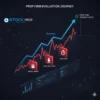Day traders focus on finding and taking advantage of trades within a day. Traders use different strategies to find these trades. However, this article will focus on patterns. Different types of candlestick and chart patterns allow traders to catch reversals and trade in the direction of the trend.
Candlestick patterns like the morning star, bullish, and bearish engulfing candlesticks can help traders pick the best reversal points. On the other hand, chart patterns like the flag and triangles show great places to enter and catch the continuation of a developed trend.
CANDLESTICK PATTERNS
Candlestick patterns are formed by one candle or a combination of two or three. These patterns can show likely reversal and continuation points and predict future price movements.
MORNING STAR
Morning star
The morning star is a bullish reversal pattern that comes at the bottom of a downtrend. It signals a looming reversal in the trend and a shift in sentiment to bullish. To identify this pattern on a stock like Apple, wait for the price to form a large bearish candle. This is the first candle in the pattern and should be red and sizeable, showing a strong downtrend.
The second candle should have a small or no body at all and can be red or green. This candle shows a period of indecision after the downtrend. The final candle should be large and green, showing a surge in bullish momentum after the period of indecision. This candle confirms the shift in sentiment that will allow the price to change direction.
A gap between these three candles makes a stronger signal. As shown in the Apple chart above, the morning star pattern formed at the bottom of the chart. After the pattern, the price remained in a range before shooting up in a new uptrend. To take advantage of such a move, enter after the pattern forms, with stops at a safe distance below the pattern. Hold the position with appropriate targets.
EVENING STAR
Evening star
The opposite of the morning star pattern is the evening star. This bearish reversal candlestick pattern forms at the top of a bullish trend. To identify this pattern, wait for the price to form a sizable green candle, showing the bullish trend. The second candle should have a tiny body, with or without wicks, showing a period of indecision. The final candle should be large and red, indicating a sudden surge in bearish momentum and confirming a reversal. A gap between the middle candle and the others increases the chances of a reversal. In the chart above, the evening star pattern leads to a bearish reversal.
BULLISH ENGULFING PATTERN
Bullish engulfing pattern
A bullish engulfing pattern forms at the bottom of a bearish trend and signals a surge in bullish momentum and a looming reversal. It comprises a red candle and a green one that completely engulfs the first candle. In the above chart showing the Apple stock, the price paused and started moving sideways at the bottom. A large green candle formed and engulfed the previous candle, indicating a shift in sentiment. After the bullish engulfing pattern, the price rallied to new peaks.
BEARISH ENGULFING PATTERN
Bearish engulfing pattern
The opposite of the bullish engulfing pattern is the bearish engulfing pattern, which forms at the top of a bullish trend. The pattern signals a surge in bearish momentum that could lead to a reversal in the trend. Wait for the price to form a green bullish candle to identify the pattern. After that, it should create a large red candle that completely engulfs the first. In the chart above, the bearish engulfing pattern formed at the top of a bullish trend, leading to a strong reversal.
CHART PATTERNS
Besides candlestick patterns, traders can use chart patterns to catch reversal and trend continuation trades.
TRIANGLE PATTERNS
Triangle pattern
The triangle pattern is very popular among traders as it identifies areas of rest during a trend. Therefore, it allows traders to enter trades in the direction of the prevailing trend. There are many types of triangles, each telling something different about price action.
In the Tesla chart above, the price has made a symmetrical triangle where the highs and lows gradually converge to a point. Before the pattern, the price was in a bullish trend. This increases the likelihood that this trend will continue. To trade the triangle, wait for the price to break out to the upside. The first target should be the height of the triangle.
Other similar patterns include the ascending and descending triangles. Ascending triangles perform best in an uptrend where bulls meet a solid resistance. The price keeps making higher lows and eventually makes a bullish breakout.
On the other hand, a descending triangle performs best during a downtrend when bears meet a solid support. The price keeps making lower highs and eventually breaks below the support to continue the downtrend.
FLAG PATTERN
Flag pattern
Another popular chart pattern is the flag. This is a continuation pattern that forms after an impulsive move. The flag pattern has formed in a downtrend in the Nvidia chart above. First came an impulsive bearish leg that formed the flagpole. After that, the price made a corrective bullish move that formed the flag. To trade this pattern, traders wait for the price to break out of the flag in the direction of the flag pole.
A flag pattern can also appear in a bullish trend to signal a pause and likely continuation of the uptrend.
HEAD AND SHOULDERS PATTERN
Head and shoulders pattern
The head and shoulders pattern appears at the top or bottom of a trend and signals a reversal. The pattern comprises two shoulders and a head. During a bullish pattern, the first shoulder comes after a strong trend. The head is the peak in the bullish trend, and the second shoulder shows weaker momentum. In the chart above, the head and shoulders pattern forms at the top of a strong bullish trend. To trade the pattern, traders wait for the price to break below the neckline connecting the shoulders and the head. The first target is the height from the head to the neckline. The pattern led to a bearish reversal, and Nvidia’s price collapsed.
DOUBLE TOP
Double top pattern
The last pattern is the double top. This reversal pattern signals a pause in the prevailing trend and a likely reversal. In the Tesla chart above, the price has made a double-top pattern after a bullish trend. The first top indicates a peak for the uptrend. Meanwhile, the second top indicates a failed attempt to create a higher high. Therefore, it is a sign that bulls are exhausted. To trade the pattern, wait for the price to break below the neckline and place your first target as the pattern’s height. The double-top pattern above eventually led to a bearish reversal.











